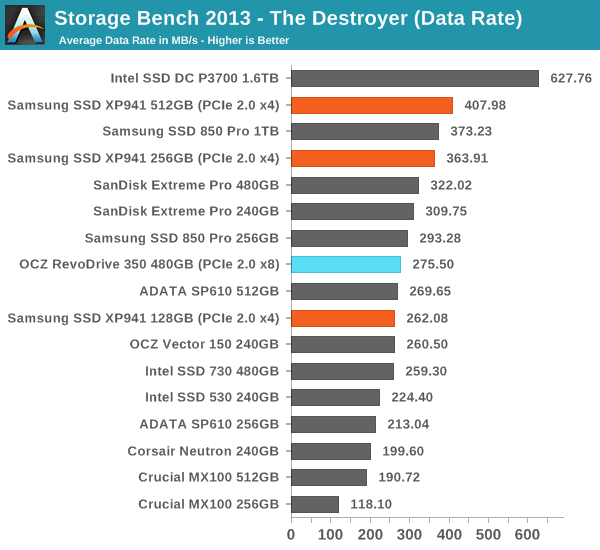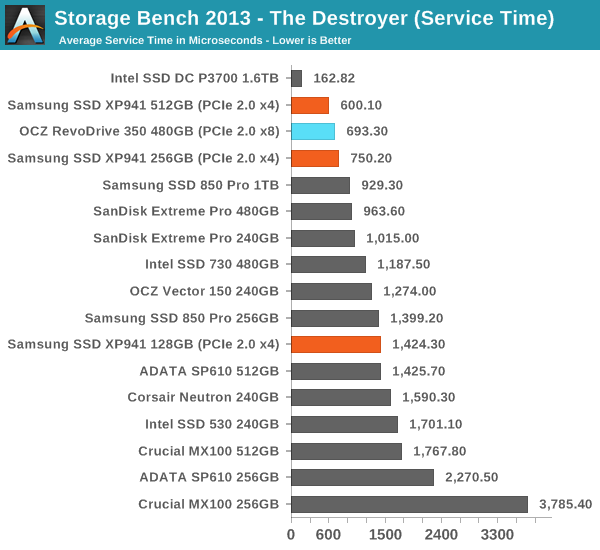PCIe SSD Faceoff: Samsung XP941 (128GB & 256GB) and OCZ RevoDrive 350 (480GB) Tested
by Kristian Vättö on September 5, 2014 3:00 PM ESTAnandTech Storage Bench 2013
Our Storage Bench 2013 focuses on worst-case multitasking and IO consistency. Similar to our earlier Storage Benches, the test is still application trace based – we record all IO requests made to a test system and play them back on the drive we are testing and run statistical analysis on the drive's responses. There are 49.8 million IO operations in total with 1583.0GB of reads and 875.6GB of writes. I'm not including the full description of the test for better readability, so make sure to read our Storage Bench 2013 introduction for the full details.
| AnandTech Storage Bench 2013 - The Destroyer | ||
| Workload | Description | Applications Used |
| Photo Sync/Editing | Import images, edit, export | Adobe Photoshop CS6, Adobe Lightroom 4, Dropbox |
| Gaming | Download/install games, play games | Steam, Deus Ex, Skyrim, Starcraft 2, BioShock Infinite |
| Virtualization | Run/manage VM, use general apps inside VM | VirtualBox |
| General Productivity | Browse the web, manage local email, copy files, encrypt/decrypt files, backup system, download content, virus/malware scan | Chrome, IE10, Outlook, Windows 8, AxCrypt, uTorrent, AdAware |
| Video Playback | Copy and watch movies | Windows 8 |
| Application Development | Compile projects, check out code, download code samples | Visual Studio 2012 |
We are reporting two primary metrics with the Destroyer: average data rate in MB/s and average service time in microseconds. The former gives you an idea of the throughput of the drive during the time that it was running the test workload. This can be a very good indication of overall performance. What average data rate doesn't do a good job of is taking into account response time of very bursty (read: high queue depth) IO. By reporting average service time we heavily weigh latency for queued IOs. You'll note that this is a metric we have been reporting in our enterprise benchmarks for a while now. With the client tests maturing, the time was right for a little convergence.

While the average data rates of the 256GB XP941 and RevoDrive are not that impressive, the average service times are. The average service time of the 256GB XP941 is nearly half of the same capacity 850 Pro and the RevoDrive too is faster than any SATA SSD, though the 512GB XP941 is still faster. The service time emphasizes high queue depth performance, which is often the stumbling stone for slower and cheaper drives, and that in turn increases their average service time.











47 Comments
View All Comments
Intervenator - Friday, September 5, 2014 - link
Need MOAR insight into the PCIe SSD market! Wheres it going? Any noticeable performance increased to the end user? Who are the players in the market? Non performance advantages?If AnandTech has already written an article regarding any of this, could someone please point me towards it?
Intervenator - Friday, September 5, 2014 - link
Oh, and great review.Kristian Vättö - Friday, September 5, 2014 - link
We haven't done an article that collects all bits of info into one, but you may find the following articles interesting:http://www.anandtech.com/show/8006/samsung-ssd-xp9...
http://www.anandtech.com/show/7843/testing-sata-ex...
http://www.anandtech.com/show/7520/lsi-announces-s...
http://www.anandtech.com/show/8147/the-intel-ssd-d...
http://www.anandtech.com/show/8104/intel-ssd-dc-p3...
frenchy_2001 - Friday, September 5, 2014 - link
>Where is it going?M.2 form factor using PCIe gen3 x4 for portable and consumer, PCIe cards, up to Gen3 x8 for Datacenter/server. Both running NVMe protocol.
I don't see much future for SATAexpress, as the 2 other competing standards cover all the use cases already (and better too).
> Any noticeable performance increased to the end user?
Not unless you do a LOT of parallel IOs. For consumer, there is a diminutive return past the original boost from switching to SSD (mostly from lower latencies). HDD to SATA SSD gave orders of magnitude improvements. SATA3 -> PCIe is only incremental compared to that. Unless you need this for a server, video processing or other big IO limited task, there will be little difference.
>Who are the players in the market?
Still the same: Intel/Micron/Samsung/Sandisk for professionals/servers using mostly in-house designs (intel P3700 for example).
Marvel and Sandforce have announced PCIe NVMe controllers. No products for those yet.
>Non performance advantages?
M.2 will be more compact. Power draw should be more optimized. NVMe should have lower processor overhead.
Impulses - Friday, September 5, 2014 - link
Thx for that.iwod - Saturday, September 6, 2014 - link
Since speed is a relative thing. The HDD to SSD leap were amazing. But that doesn't mean you cant feel the different between SSD @ SATA 3GBps and SSD@ 6Gbps. And with the recent controller improvement on Random / Seq RW, I can also feel the difference between SATA and NVMe PCIe SSD.But with the increase memory capacity, the time to fetch things SSD will also be lower since they are likely cached. So throughput may become less of a concern after PCIe SSD, and average response time will play a role. Luckily this is already being worked on for server SSD usage. So they will likly filter down once PCIe SSD becomes mainstream.
For the future I would like to see even lower active power consumption. I wonder if they could get it under 2W.
Friendly0Fire - Friday, September 5, 2014 - link
This makes me think that the SM951 with X99 will be one hell of a beast... I want one. Heck, the XP941 would already be amazing.GrigioR - Friday, September 5, 2014 - link
Is it possible to boot from those PCIe drives using a 775 motherboard (p35chipset)? Getting rid of Satall bottleneck would be awesome on my modded Xeon system.Kristian Vättö - Friday, September 5, 2014 - link
The SM951 likely won't be bootable since it is an OEM drive, but there will be retail PCIe SSDs that are bootable even in older systems (the Plextor M6e should be, for instance).GrigioR - Sunday, September 7, 2014 - link
Nice. Too pricey 1$/GB on the 256GB model... Since my motherboard is PCIe 1.0/1.1 it would run at 500MB/s max... That should not be that noticieable. My Samsung 840 120/128GB runs at +- 250-260MB/s (read)... At least if it were a PCIe x4 it would do 1000MB (bus speed). I`ll leave this the way it is for now. Thank you very much for your input. Now i know it is possible.